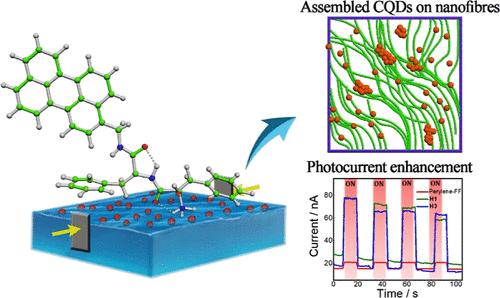Our official English website, www.x-mol.net, welcomes your
feedback! (Note: you will need to create a separate account there.)
Interfacial Assembly of Peptide Carbon Dot Hybrids Enables Photoinduced Electron Transfer with Improved Photoresponse
Langmuir ( IF 3.7 ) Pub Date : 2024-11-16 , DOI: 10.1021/acs.langmuir.4c03597 Pramita Mondal, Umesh, Niladri Hazra, Joydeep Datta, Sharmistha De Dalui, Anashmita Ghosh, Somobrata Acharya, Santanu Bhattacharya
Langmuir ( IF 3.7 ) Pub Date : 2024-11-16 , DOI: 10.1021/acs.langmuir.4c03597 Pramita Mondal, Umesh, Niladri Hazra, Joydeep Datta, Sharmistha De Dalui, Anashmita Ghosh, Somobrata Acharya, Santanu Bhattacharya

|
Assemblies at the interface represent a powerful tool for integrating organic and inorganic components into hybrid nanostructures. Carbon dots are both excellent electron donors and acceptors, offering opportunities for their potential uses in light-harvesting applications. To further improve their functions, integration of acceptor carbon dots into donor organic nanostructures is of great interest for improving photophysical properties useful for photoinduced electron transfer. Here, a one-step protocol for the interfacial assembly of a two-component hybrid consisting of carbon dots and perylene containing an l-phenylalanine-based dipeptide through noncovalent bonding is developed. The perylene-containing dipeptide derivative formed micrometer-long nanofibers on the water surface through J-aggregate formation. Spectroscopic studies reveal photoluminescence quenching of the donor dipeptide upon increasing the concentration of acceptor carbon dots in the hybrid, suggesting photoinduced electron transfer from the donor peptides to acceptor carbon dots. The hybrids integrated in a planar device architecture show a significantly improved photoresponse because of the favorable interactions between the donor–acceptor components. The one-step integration of donor–acceptor hybrids on the water surface offers opportunities for light harvesting and related applications.
中文翻译:

肽碳点杂化物的界面组装可实现光诱导电子转移并改善光响应
界面处的组装体是将有机和无机成分集成到混合纳米结构中的强大工具。碳点既是极好的电子供体又是受体,为它们在光收集应用中的潜在应用提供了机会。为了进一步改善它们的功能,将受体碳点整合到供体有机纳米结构中对于改善可用于光诱导电子转移的光物理特性具有重要意义。在这里,开发了一种一步法方案,用于通过非共价键对由碳点和苝组成的双组分杂化物进行界面组装,其中含有基于 l-苯丙氨酸的二肽。含苝的二肽衍生物通过 J 形聚集体的形成在水面上形成微米长的纳米纤维。光谱研究表明,在杂化体中受体碳点浓度增加时,供体二肽的光致发光猝灭,表明光诱导电子从供体肽转移到受体碳点。由于供体-受体成分之间的良好相互作用,集成在平面器件架构中的杂化物显示出显着改善的光响应。供体-受体杂交体在水面上的一步整合为光收集和相关应用提供了机会。
更新日期:2024-11-16
中文翻译:

肽碳点杂化物的界面组装可实现光诱导电子转移并改善光响应
界面处的组装体是将有机和无机成分集成到混合纳米结构中的强大工具。碳点既是极好的电子供体又是受体,为它们在光收集应用中的潜在应用提供了机会。为了进一步改善它们的功能,将受体碳点整合到供体有机纳米结构中对于改善可用于光诱导电子转移的光物理特性具有重要意义。在这里,开发了一种一步法方案,用于通过非共价键对由碳点和苝组成的双组分杂化物进行界面组装,其中含有基于 l-苯丙氨酸的二肽。含苝的二肽衍生物通过 J 形聚集体的形成在水面上形成微米长的纳米纤维。光谱研究表明,在杂化体中受体碳点浓度增加时,供体二肽的光致发光猝灭,表明光诱导电子从供体肽转移到受体碳点。由于供体-受体成分之间的良好相互作用,集成在平面器件架构中的杂化物显示出显着改善的光响应。供体-受体杂交体在水面上的一步整合为光收集和相关应用提供了机会。


















































 京公网安备 11010802027423号
京公网安备 11010802027423号